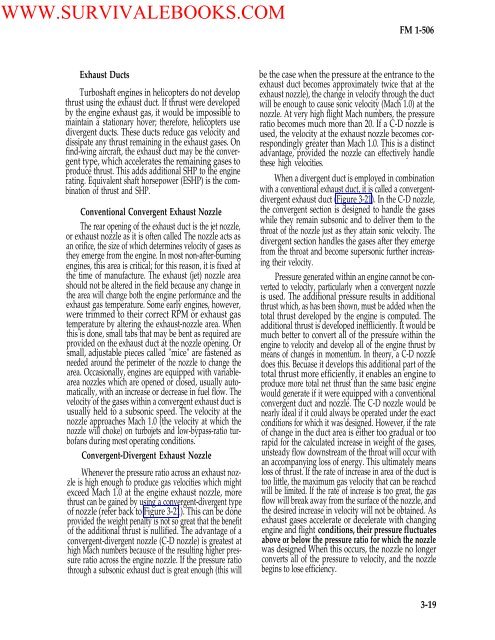FM 1-506 Fundamentals of Aircraft Power Plants ... - Survival Books
FM 1-506 Fundamentals of Aircraft Power Plants ... - Survival Books
FM 1-506 Fundamentals of Aircraft Power Plants ... - Survival Books
Create successful ePaper yourself
Turn your PDF publications into a flip-book with our unique Google optimized e-Paper software.
WWW.SURVIVALEBOOKS.COM<strong>FM</strong> 1-<strong>506</strong>Exhaust DuctsTurboshaft engines in helicopters do not developthrust using the exhaust duct. If thrust were developedby the engine exhaust gas, it would be impossible tomaintain a stationary hover; therefore, helicopters usedivergent ducts. These ducts reduce gas velocity anddissipate any thrust remaining in the exhaust gases. Onfind-wing aircraft, the exhaust duct may be the convergenttype, which accelerates the remaining gases toproduce thrust. This adds additional SHP to the enginerating. Equivalent shaft horsepower (ESHP) is the combination<strong>of</strong> thrust and SHP.Conventional Convergent Exhaust NozzleThe rear opening <strong>of</strong> the exhaust duct is the jet nozzle,or exhaust nozzle as it is <strong>of</strong>ten called The nozzle acts asan orifice, the size <strong>of</strong> which determines velocity <strong>of</strong> gases asthey emerge from the engine. In most non-after-burningengines, this area is critical; for this reason, it is fixed atthe time <strong>of</strong> manufacture. The exhaust (jet) nozzle areashould not be altered in the field because any change inthe area will change both the engine performance and theexhaust gas temperature. Some early engines, however,were trimmed to their correct RPM or exhaust gastemperature by altering the exhaust-nozzle area. Whenthis is done, small tabs that may be bent as required areprovided on the exhaust duct at the nozzle opening. Orsmall, adjustable pieces called "mice" are fastened asneeded around the perimeter <strong>of</strong> the nozzle to change thearea. Occasionally, engines are equipped with variableareanozzles which are opened or closed, usually automatically,with an increase or decrease in fuel flow. Thevelocity <strong>of</strong> the gases within a convergent exhaust duct isusually held to a subsonic speed. The velocity at thenozzle approaches Mach 1.0 (the velocity at which thenozzle will choke) on turbojets and low-bypass-ratio turb<strong>of</strong>ansduring most operating conditions.Convergent-Divergent Exhaust NozzleWhenever the pressure ratio across an exhaust nozzleis high enough to produce gas velocities which mightexceed Mach 1.0 at the engine exhaust nozzle, morethrust can be gained by using a convergent-divergent type<strong>of</strong> nozzle (refer back to Figure 3-21). This can be doneprovided the weight penalty is not so great that the benefit<strong>of</strong> the additional thrust is nullified. The advantage <strong>of</strong> aconvergent-divergent nozzle (C-D nozzle) is greatest athigh Mach numbers becausce <strong>of</strong> the resulting higher pressureratio across the engine nozzle. If the pressure ratiothrough a subsonic exhaust duct is great enough (this willbe the case when the pressure at the entrance to theexhaust duct becomes approximately twice that at theexhaust nozzle), the change in velocity through the ductwill be enough to cause sonic velocity (Mach 1.0) at thenozzle. At very high flight Mach numbers, the pressureratio becomes much more than 20. If a C-D nozzle isused, the velocity at the exhaust nozzle becomes correspondinglygreater than Mach 1.0. This is a distinctadvantage, provided the nozzle can effectively handlethese high velocities.When a divergent duct is employed in combinationwith a conventional exhaust duct, it is called a convergentdivergentexhaust duct (Figure 3-21). In the C-D nozzle,the convergent section is designed to handle the gaseswhile they remain subsonic and to deliver them to thethroat <strong>of</strong> the nozzle just as they attain sonic velocity. Thedivergent section handles the gases after they emergefrom the throat and become supersonic further increasingtheir velocity.Pressure generated within an engine cannot be convertedto velocity, particularly when a convergent nozzleis used. The additional pressure results in additionalthrust which, as has been shown, must be added when thetotal thrust developed by the engine is computed. Theadditional thrust is developed ineffliciently. It would bemuch better to convert all <strong>of</strong> the pressure within theengine to velocity and develop all <strong>of</strong> the engine thrust bymeans <strong>of</strong> changes in momentum. In theory, a C-D nozzledoes this. Becuase it develops this additional part <strong>of</strong> thetotal thrust more efficiently, it enables an engine toproduce more total net thrust than the same basic enginewould generate if it were equipped with a conventionalconvergent duct and nozzle. The C-D nozzle would benearly ideal if it could always be operated under the exactconditions for which it was designed. However, if the rate<strong>of</strong> change in the duct area is either too gradual or toorapid for the calculated increase in weight <strong>of</strong> the gases,unsteady flow downstream <strong>of</strong> the throat will occur withan accompanying loss <strong>of</strong> energy. This ultimately meansloss <strong>of</strong> thrust. If the rate <strong>of</strong> increase in area <strong>of</strong> the duct istoo little, the maximum gas velocity that can be reachcdwill be limited. If the rate <strong>of</strong> increase is too great, the gasflow will break away from the surface <strong>of</strong> the nozzle, andthe desired increase in velocity will not be obtained. Asexhaust gases accelerate or decelerate with changingengine and flight conditions, their pressure fluctuatesabove or below the pressure ratio for which the nozzlewas designed When this occurs, the nozzle no longerconverts all <strong>of</strong> the pressure to velocity, and the nozzlebegins to lose efficiency.3-19
















